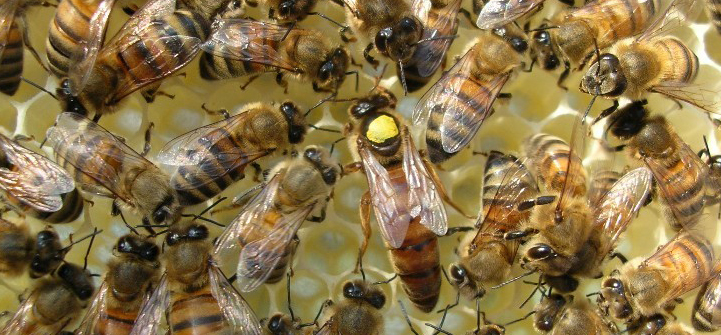
A presentation at a honey bee conference. Credit:Zach Huang
Researchers and other knowledgeable individuals commonly give presentations on their area of expertise, either at conferences or other smaller meetings. We try to record these seminars whenever possible to allow the widest audience for the presentation. Overtime some of the links to a seminar may be broken and unrecoverable, we will attempt to maintain an up-to-date list of our video content. Webinars and seminars that are recorded, archived online, and available for free can be found below. Other videos can be found on our YouTube channel.
- 2017 Bee Health Webinar Series: Ensuring Crop Pollination in US Specialty Crops
- Seminars Web-Cast from UC Davis
-
Proceeding of the American Bee Research Conference 2010
- A New Assay to Measure Mite Grooming Behavior
- Pesticide in Pollen Trapped from Honey Bee Hives in Connecticut
- A Test for Sub-acute Effects of Some Commonly Used Bee Hive Chemicals
- Pests Pathogens and Queen Losses in Commercial Migratory Operations
- Apis mellifera Proteomics of Innate Resistance
- Variability and Correlations Among Five Traits Associated with American Foulbrood Resistance in a Canadian Breeding Population
- Effects of a Miticide on Honeybee Memory – is the Cure Worse than the Disease
- Nosema ceranae in North America Nasty Nice or Neither
- Beneficial Microflora in Honey Bee Colonies
- Molecular Diagnostics of Nosema ceranae and apis from Honey Bees in New York
- Nestmate Recognition in the Honey Bee Apis mellifera
- Effects of Varroa Mites and Bee Diseases on Pollination Efficacy of Honey Bees
- Effect of Transportation on Honey Bee Physiology
- Disinfection of Nosema ceranae Infected Comb by Irradiation Acetic Acid and Heat
- Interactions Between Nosema Microspores and a Neonicotinoid on Honey Bees
- Pesticide Analysis at the Stationary Apiaries
- Bee Health at eXtension
- Drug Interactions Between In-hive Miticides and Fungicides in Honey Bees
- Bee CAP Overview and Stationary Apiaries
- Preference of Phoretic Mites for Young Bees Increase Varroa Fitness
- Varroa Sensitive Hygiene and Mite Reproduction
- Safe Exchange of Honey Bee Germplasm
-
Proceeding of the American Bee Research Conference 2011
- The Good the Bad and the Ugly Varroa Mite Control Strategy
- The CAP Stationary Apiary Project: A Synopsis of Colony Strength and Preliminary Statistical Modeling 2009-20010
- Varroacide Effects on Honey Bee Queens
- Bees Under Surveillance: Using Video-Tracking to Monitor Honey Bee Activity After Sublethal Exposure to Pesticides
- Evaluation of Honey Production and Varroa Mite Load in Russian and VSH Bees
- Broodmapper: Developing a Web-Based Game to Detect Pesticide Effects in Honey Bee Brood
- Report on Pesticides Found in Pollen and Bee Bread in Colonies Placed in California Almond Orchards
- A Primer on Pesticide Formulation ‘inerts’ and Honey Bees
- Challenges for Developing Biopesticides Against Varroa
- Relay Effect in Landscape Learning in Honey Bees and its use for Detecting Subtle Effects of Pesticides.
- Examination on the Reproductive Success of Re-invading Varroa Mites
- Determining the Botanical Origins of Plant Resins Collected by Apis mellifera with Metabolic Fingerprinting Analysis
- Location Location Location How Landscape Quality Affects Honey Bee Health
- Bee Communities at Crop Flowers and Bee Food Plots
- Identifying Candidate Genes for Honey Bee Mite-Grooming Behavior Using Fine-Scale Linkage Mapping
- If Flowers are Restaurants to Bees, Then What Are Bees to Flowers?
